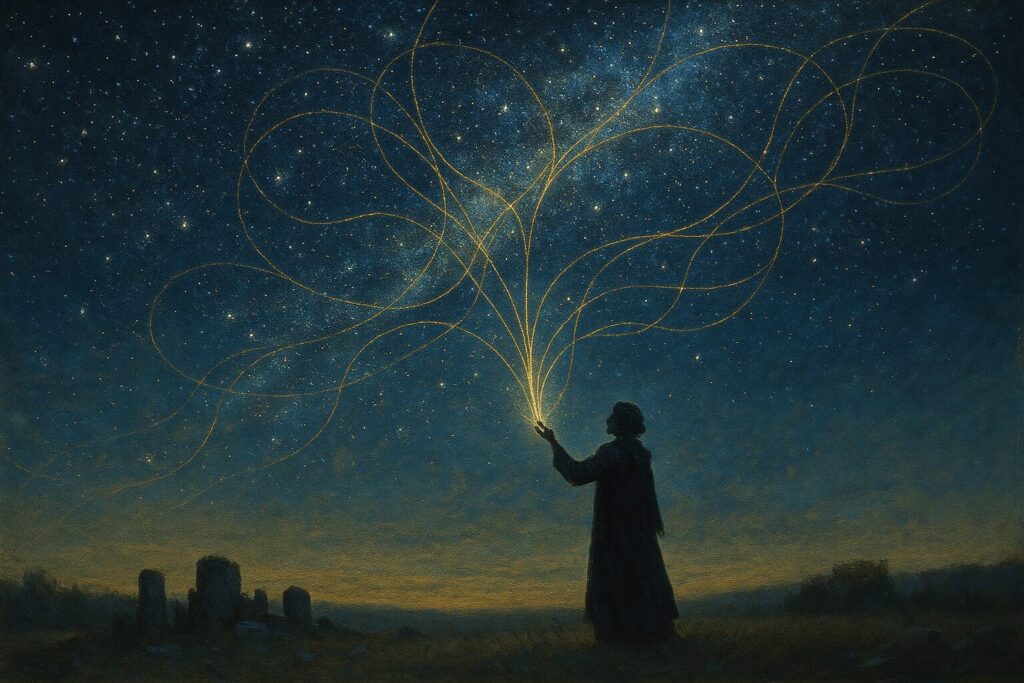Visitors from the Sky: Spirits, Aliens, and the Changing Myth of the Beyond

Humanity has always looked upward for meaning. The dome of the heavens once shimmered with gods, ancestors, and prophetic fire—its lights moving not through emptiness, but along invisible threads of life. The ancients spoke of a living cosmos, a divine fabric binding mortal and divine. Plato called it the anima mundi, the world-soul, through which all beings shared one breath. The Hermetic writers described it as a golden chain, the “filament” of spirit drawn through every star, every heartbeat, every atom. To them, the air between worlds was not void but alive: a field of thought, will, and divine motion. Daimons, angels, and spirits were the intermediaries that moved along these filaments, messengers of the unseen currents between gods and humankind.
Over centuries, our understanding of that shining web changed. The telescope, the laboratory, the slow unfolding of reason—all stripped away the old imagination of the heavens as ensouled. What was once the celestial realm became an astronomical coordinate system; the music of the spheres became background radiation. The living filament was replaced by electromagnetic waves and gravitational fields. Yet even as cosmology became mechanical, the human psyche did not stop yearning for connection. The need for transcendence simply found new metaphors. Where Plato saw the world-soul, we see the quantum field. Where angels once descended, now UFOs streak across the sky. The mystery was not abolished—only translated into the language of a technological age.
Modern “alien” experience is, in many ways, a re-enchantment of the disenchantment. In a world where divinity seems to have retreated, some imagine the gods returning in silver ships. The alien serves as a myth for the modern mind: rational enough to believe in, numinous enough to feel divine. The abduction vision echoes the ancient motif of divine encounter—ravishment, revelation, hybrid birth—yet stripped of its temple and rite. Psychologically, it is a dream of transcendence recast in the idiom of science fiction. We no longer climb Jacob’s ladder; we board a craft of light.
There is a certain dry humor in this evolution. The gods, once banished by secularism, return disguised as scientists from another planet. The myth adapts to our worldview like a virus adapting to its host: what the age will not call “angelic” it names “extraterrestrial.” Each culture shapes the unknown in its own image, and the modern image is technological. Yet behind the radar blips and conspiracy forums lies the same hunger the ancients felt—the ache to know that we are not alone, that consciousness stretches beyond the skull.

It is this hunger that sometimes turns dangerous. When belief loses its grounding in soul, it seeks certainty in spectacle. The tragic devotion of the Heaven’s Gate cult, awaiting salvation through the Hale-Bopp comet, shows how easily yearning for transcendence can collapse into pathology. Such movements echo older forms of apocalyptic zeal, but without the stabilizing ritual, cosmology, or wisdom that once framed visionary experience. The stars have not betrayed us; rather, we have forgotten how to walk between them wisely.
For modern Pagans and practitioners of the Craft, the alien myth invites reflection rather than rejection. The notion of distant intelligences is not impossible, only uncertain. There may well be life beyond this world—but the effort to commune with it must not eclipse the intimacy of spirit already present in wind, water, and flame. The gods of the old mysteries—Hermes who crosses thresholds, Isis who gathers the fragments, Dionysus who dissolves the boundaries—still speak through the same filament of being that binds heaven to earth. Their messages arrive not through abduction, but through the shimmering language of nature, dream, and intuition.
Perhaps the cosmos is indeed teeming with life, but if so, the first step toward meeting it begins not with telescopes or trance but with attention—with reawakening the sense that this world itself is sacred. To chase the sky and neglect the soil is to miss the miracle underfoot. Magic is not the art of fleeing the human condition, but of revealing its hidden luminosity. We are already citizens of a vast and living universe; the true alienation is forgetting that truth.
In the end, every age clothes its mysteries in the garb it understands. The ancients saw wings of light; we see circuitry. The filament remains, humming beneath our metaphors, waiting for us to remember that it was never out there, but here—woven through body, mind, and earth alike.
